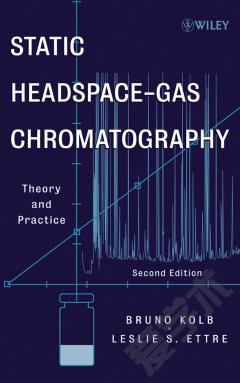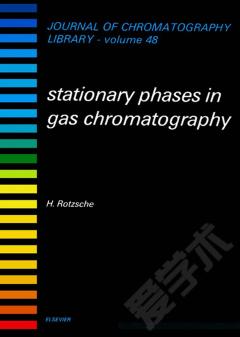Static Headspace-Gas Chromatography
Preface. Preface to the First Edition. List of Acronyms and Symbols. 1. General introduction. 1.1 Principles of headspace analysis . 1.2 Types of headspace analysis. 1.2.1 Principles of static headspace - gas chromatography (HS-GC). 1.2.2 Principles of dynamic headspace -- gas chromatography. 1.3 The evolution of the HS-GC methods. 1.4 Headspace -- gas chromatography literature. 1.5 Regulatory methods utilizing (static) HS-GC. 1.6 References. 2. Theoretical background of HS-GC and its applications. 2.1 Basic theory of headspace analysis. 2.2 Basic physicochemical relationships. 2.3 Headspace sensitivity. 2.3.1 Influence of temperature on vapor pressure and partition coefficient. 2.3.2 Influence of temperature on headspace sensitivity for compounds with differing partition coefficients. 2.3.3 Influence of sample volume on headspace sensitivity for compounds with differing partition coefficients. 2.3.4 Changing the sample matrix by varying the activity coefficient. 2.4 Headspace linearity. 2.5 Duplicate analyses. 2.6 Multiple headspace extraction (MHE). 2.6.1 Principles of MHE. 2.6.2 Theoretical background of MHE. 2.6.3 Simplified MHE calculation. 2.7 References. 3. The technique of HS-GC. 3.1 Sample vials. 3.1.1 Types. 3.1.2 Selection of vial volume. 3.1.3 Vial cleaning. 3.1.4 Wall adsorption effects. 3.2 Caps. 3.2.1 Pressure on caps. 3.2.2 Safety closures. 3.3 Septa. 3.3.1 Types. 3.3.2 Septum blank. 3.3.3 Should a septum be pierced twice?. 3.4 Thermostatting. 3.4.1 Influence of temperature. 3.4.2 Working modes. 3.5 The fundamentals of headspace sampling systems. 3.5.1 Systems using gas syringes. 3.5.2 Solid-phase microextraction (SPME). 3.5.2.1 Comparison of the sensitivities in HS-SPME and direct static HS-GC. 3.5.3 Balanced-pressure sampling systems. 3.5.4 Pressure/loop systems. 3.5.5 Conditions for pressurization systems. 3.5.6 The volume of the headspace sample. 3.5.6.1 Sample volume with gas syringes. 3.5.6.2 Sample volume with loop systems. 3.5.6.3 Sample volume with the balanced-pressure system. 3.6 Use of open-tubular (capillary) columns. 3.6.1 Properties of open-tubular columns for gas samples. 3.6.2 Headspace sampling with split or spitless?. 3.6.3 Comparison of split- and splitless headspace sampling. 3.6.4 Band broadening during sample introduction. 3.6.5 Temperature influence on band broadening. 3.6.6 The combination of different columns and detectors. 3.7 Enrichment techniques in HS-GC. 3.7.1 Systems for cryogenic trapping. 3.7.1.1 Systems for Cryogenic condensation. 3.7.1.2 Trapping by cryogenic focusing. 3.7.1.3 Influence of temperature on cryogenic focusing. 3.7.1.4 Comparison of the various techniques of cryogenic trapping. 3.7.2 Influence of water in cryogenic HS-GC. 3.7.2.1 Water removal in static HS-GC. 3.7.2.2 Applications. 3.7.3 Enrichment by adsorption. 3.7.3.1 Water removal from an adsorption trap. 3.8 Special techniques with the balanced-pressure systems. 3.8.1 Instrumentation for MHE. 3.8.2 Backflushing. 3.9. Reaction HS-GC. 3.9.1 Derivatization in the headspace vial. 3.9.1.1 Methylation. 3.9.1.2 Esterification. 3.9.1.3 Transesterification. 3.9.1.4 Acetylation. 3.9.1.5 Carbonyl compounds. 3.9.2 Subtraction HS-GC. 3.9.3 Special reactions. 3.9.4 HS-GC analysis of volatile derivatives from inorganic compounds. 3.10 References. 4. Sample handling in HS-GC. 4.1 Equilibration. 4.1.1 Gas samples. 4.1.2 Liquid samples. 4.1.3 Solid samples. 4.2 Solution approach. 4.3 Sample handling and sample introduction. 4.3.1 Gas samples. 4.3.2 Liquid samples. 4.3.3 Solid samples. 4.4 Preparation of standard solutions. 4.4.1 Preparation of a standard solution from a liquid or solid substance. 4.4.2 Preparation of a standard solution from a gaseous compound. 4.5 Influence of the matrix. 4.5.1 Clean matrix is available. 4.5.2 Matric effect can be eliminated. 4.5.3 Artificial matrix can be prepared. 4.6 Methods aiming the complete evaporation of the analyte. 4.6.1 The total vaporization technique (TVT). 4.6.2 The full evaporation technique (FET). 4.6.3 Calculation of the extraction yield in FET. 4.6.4 Comparison of headspace sensitivities. 4.7 References. 5. Headspace methods for quantitative analysis. 5.1 Internal normalization. 5.2 Internal standard method. 5.3 External standard method. 5.4 Standard addition method. 5.4.1 Single addition. 5.4.2 Handling of the added standard (Gas-phase addition and sample-phase addition). 5.4.3 Determination by multiple additions. 5.5 Multiple headspace extraction (MHE). 5.5.1 Principles of MHE. 5.5.2 Calibration in MHE. 5.5.2.1 External standard. 5.5.2.2 Internal standard. 5.5.2.3 Standard addition. 5.5.3 The use of gaseous external standards in MHE. 5.5.4 The role of quotient Q. 5.5.4.1 Relationship between Q and pressures. 5.5.4.2 Value of Q in the case of total vaporization. 5.5.4.3 The relative position of the MHE plots as a function of Q. 5.5.5 The correlation coefficient (r). 5.5.6 Evaluation of the shape of the regression plot. 5.5.7 Influence of K/s. 5.6 Analysis of solid samples (adsorption systems). 5.6.1 Suspension approach. 5.6.2 Surface-modification techniques. 5.6.3 Highly adsorptive samples. 5.7 Calibration techniques with headspace samples of varying volumes. 5.8 Analysis of gas samples. 5.9 References. 6. Method development in HS-GC. 6.1 General guidelines. 6.2 Determination of the residual monomer content of polystyrene pellets. 6.2.1 First approach: use of internal standard with MHE. 6.2.2 Second approach: single determination with internal standard. 6.2.3 Third approach: use of external standard with MHE. 6.2.4 Fourth approach: use of the solution approach. 6.3 Determination of residual solvents in a printed plastic film. 6.3.1 First approach: use of external standard with MHE. 6.3.2 Second approach: use of standard addition with MHE. 6.3.3 Third approach: use of internal standard. 6.4 Determination of the volatile constituents of a cathodic electrolytic plating bath. 6.4.1 First approach: use of external standard with MHE. 6.4.2 Second approach: dilution and use of external standard. 7. Nonequilibrium static headspace analysis. 7.1 Accelerated analysis. 7.2 Heat-sensitive samples. 7.3 References. 8. Qualitative analysis by HS-GC. 8.1 The use of HS-GC in 'fingerprinting.'. 8.2 The use of headspace sampling in hyphenated systems. 8.3 The use of HS-GC in microbiology. 8.4 References. 9. Special measurements. 9.1 Determination of vapor pressures. 9.2 Determination of activity coefficients. 9.3 Determination of related physicochemical functions. 9.4 Determination of phase distribution (partition coefficient). 9.4.1 The vapor-phase calibration (VPC) method. 9.4.2 The phase-ratio variation (PRV) method. 9.4.3 MHE methods for the determination of the partition coefficient. 9.5 Reaction constant measurements. 9.6 Determination of solute solubility by MHE. 9.7 Gas-solid systems. 9.7.1 Determination of adsorption isotherms. 9.7.2 Determination of the rate of release of a volatile analyte. 9.8 Validation of the headspace instrumentation: investigation of detector linearity and detection limit. 9.8.1 Definitions. 9.8.2 Linear range of the detector. 9.8.3 Precision of the range. 9.8.4 Minimum detectability. 9.9 References. Index.
{{comment.content}}








 京公网安备 11010802027623号
京公网安备 11010802027623号